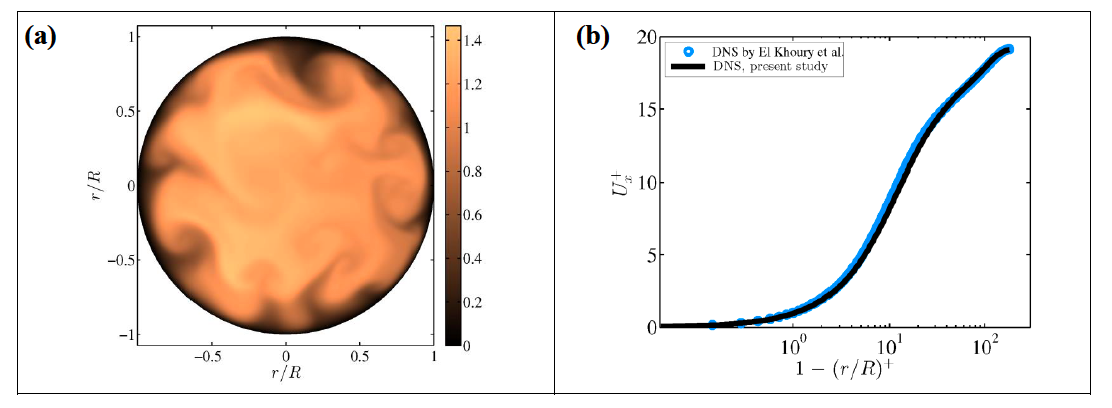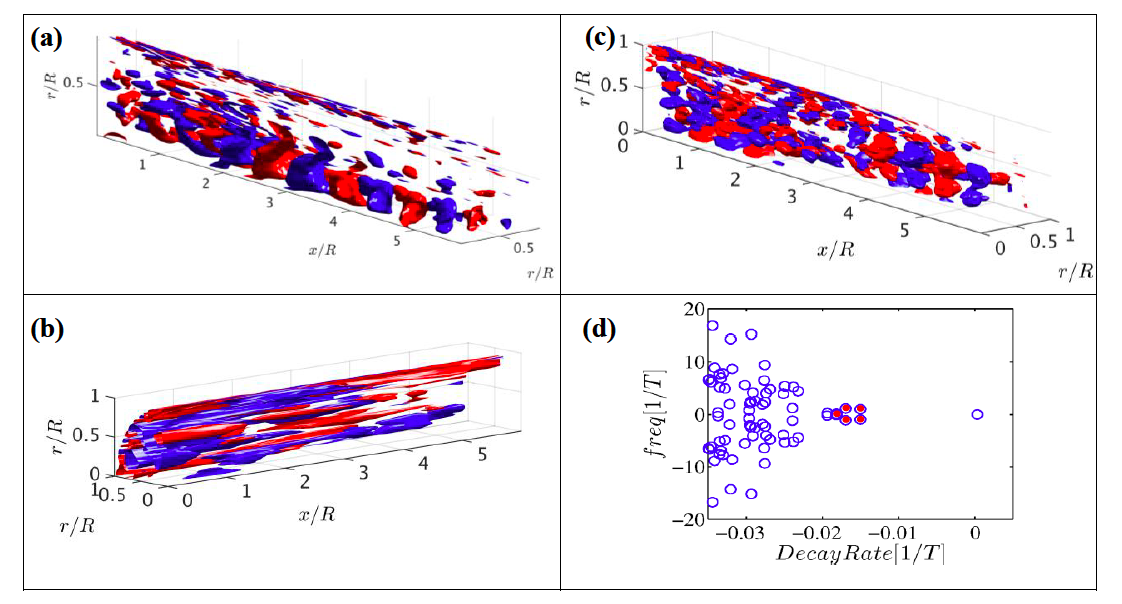Aerodynamics
Boundary layer flows
Large scale structures in fully developed turbulent pipe flow
For almost a century, wall bounded turbulent shear flows have been regarded as an attractive topic for physicists, mathematicians and engineers and have inspired wide ranges of studies. In most practical and industrial applications, the Reynolds number acquires very high values leading to large energy losses which are caused by turbulence dissipation. During the recent years there has been an increasing interest in observation and understanding of large scale turbulent coherent structures forming Large and Very Large Scale Motions (LSM and VLSM) in wall bounded turbulent flows. Nevertheless, a solid definition of their nature and vivid understanding of their evolution is still missing. Given the energetic nature of such organized motions, they play a major role in the total energy budgets of the flow. Therefore, detailed study of such motions can result in a more realistic prediction of losses, efficient flow control and reduction of energy consumption.
In spite of the increased interest in numerical study of this type of flow, Direct Numerical Simulations (DNS) are still limited in Reynolds number and domain size. Studies by Wu et al. (2012) and El Khoury et al. (2013) are among the prominent works that while extending the Reynolds number limits, have dedicated their attention to statistical flow properties and turbulent coherent structures.
In the first phase of this study DNS is carried out for fully developed incompressible turbulent pipe flow at medium to high Reynolds numbers. To this end a hybrid parallel DNS code is used in collaboration with the research group in University of Bremen who has provided the code. The incompressible Navier-Stokes equations are solved in cylindrical coordinates for velocity and pressure. More details on the numerical scheme can be found in the study by Shi et al (2015).The results will be used to study the statistical turbulent properties and to compare them with the experimental results measured at CoLa pipe. Contour plot of streamwise velocity is depicted in figure (1.a) at bulk Reynolds number of Reb=5300 and the mean velocity profile is compared against the DNS results by El Khoury et al. (2013).
In the second phase, with the aim of capturing the energetic large-scale structures, a Dynamic Mode Decomposition is carried out on the DNS data in a moving frame of reference, chosen based on the most dominant convective velocity detected in the flow. Modes with the smallest decay rates and largest contributions to the full-field will be selected and reconstructed in time to represent a reduced order model of the flow. Details of the method are presented in Sesterhenn & Shahirpour (2016) [under review]. This approach has been applied to DNS data by Wu et al. (2012). Reconstructions of the first 3 modes are presented in Figures (2.a, b, c).The decay rates and frequencies of the modes are shown in the spectrum in Figure (2.d).
The main objective that this study seeks to fulfill through the mentioned steps, is to detect large-scale energetic motions in turbulent pipe flows. We aim at clarifying the interactions between such motions, their contributions to near wall turbulence, their length scales, decay rates, life times and energy contents. The study is carried out within the frame work of DFG-SPP 1881 “Turbulent Superstructures” coordinated by J. Schumacher (TU Ilmenau), with the grant number (EG100/24-1) and in direct cooperation with our SPP partner, University of Bremen (M. Avila) who has provided the numerical code. Results of this collaborative study will be compared with the experimental data measured in CoLa-Pipe at BTU Cottbus within the bulk Reynolds number range of 8x104 ≤ Reb ≤ 1x106 (based on diameter D and bulk velocity Ub). Simulations are running on HLRN-Berlin with project number bbi00011.
Bibliography:
- El Khoury, G. K., Schlatter, P., Noorani, A., Fischer, P. F., Brethouwer, G., Johansson, A. V,"Direct Numerical Simulation of Turbulent Pipe Flow at Moderately High Reynolds Numbers", Flow Turbulence Combust. 91, 475-495, 2013
- Wu, X., Baltzer, J. R., Adrian R. J.,"Direct numerical simulation of a 30R long turbulent pipe flow at Reτ = 685: large- and very large-scale motions", J. Fluid Mech., vol. 698, pp. 235-281, 2012
- She, L., Rampp, M., Hof, B., Avila, M., "A hybrid MPI-OpenMP parallel implementation for pseudospectral simulations with application to Taylor-Couette flow", Computer and Fluids, 106, 1-11, 2015
- Sesterhenn, J., Shahirpour, A., "A lagrangian dynamic mode decomposition", submitted in 2016 to the J. Theoretical and computational fluid dynamics (under review)


